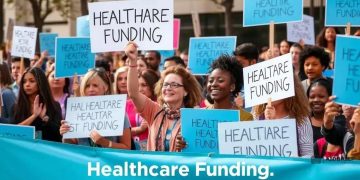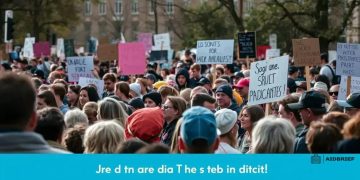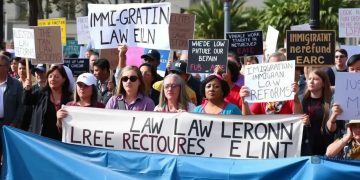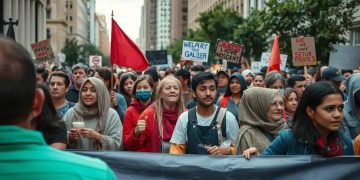Capitol Hill demonstrations over budget cuts spark debate
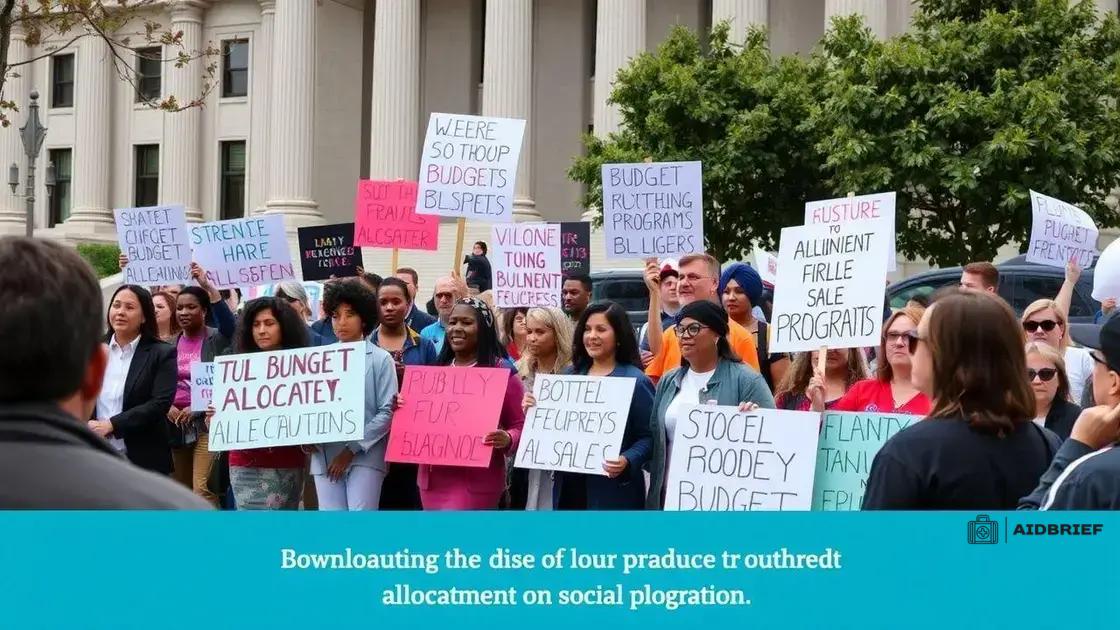
The Capitol Hill demonstrations over budget cuts highlight significant community concerns regarding the impact on essential services like education and healthcare, emphasizing the need for sustainable government funding.
Have you seen the news about the Capitol Hill demonstrations over budget cuts? They have brought a surge of concerns among citizens regarding how government funding affects our daily lives. Dive into the details with us.
Understanding the reasons behind the demonstrations
The recent Capitol Hill demonstrations over budget cuts have captured public attention and stirred intense discussions. These protests are not just about numbers; they reflect deep concerns regarding the future of essential services in our communities.
To grasp the underlying reasons behind these demonstrations, we must consider several key factors that fuel public outcry.
Public Services at Risk
When budget cuts are proposed, they often target vital public services such as education, healthcare, and transportation. People are concerned that depriving resources from these areas could diminish quality of life for many.
Unequal Impact
Another significant point is that budget cuts do not affect everyone equally. Low-income communities often bear the brunt, leading to increased anger and frustration. Many feel that their voices are not being heard, which compels them to take action.
- Education funding cuts threaten school programs.
- Healthcare reductions may lead to longer wait times.
- Transportation cuts can affect commuting options for workers.
- Social services face significant layoffs and reductions.
Furthermore, the lack of transparency in how budget decisions are made only fuels distrust towards government officials. Citizens want clarity on where funds are allocated and the reasoning behind these choices. When decisions appear to be made behind closed doors, it can feel like democracy is being circumvented.
Moreover, as national debates around economic priorities continue, many feel that essential services should not be compromised for other interests. In light of rising living costs, the demand for sustainable funding increases.
Key players and organizations involved
In the ongoing Capitol Hill demonstrations over budget cuts, various key players and organizations play a crucial role. Understanding who is involved helps to clarify the motivations and objectives behind the protests.
First, advocacy groups are often at the forefront, mobilizing citizens to voice their concerns. These organizations strive to ensure that the voices of those affected by budget cuts are heard, and they often facilitate rallies and gatherings.
Major Advocacy Groups
Some of the most prominent advocacy groups include:
- The American Civil Liberties Union (ACLU) – they support civil rights amid budget issues.
- National Education Association (NEA) – advocates for education funding.
- United Way – focuses on social services and community support.
- Health Care for America Now (HCAN) – champions healthcare access for all.
Another significant player includes local grassroots organizations. These groups are often composed of community members who are directly affected by budget decisions. They work tirelessly to organize protests, raise awareness, and encourage civic participation.
In addition, politicians themselves are key figures in these demonstrations. They may either support or oppose the budget cuts, depending on their political affiliations and constituents’ needs. Elected officials often attend or speak at rallies to show solidarity with the protesters.
Government Officials
Examples of government positions involved often include:
- Senators who advocate for public funding choices.
- House Representatives who represent impacted communities.
- Local leaders who address constituents’ concerns.
- City council members discussing municipal budget impacts.
Media also plays a vital role in covering these events. Their reports help to inform the public and create a broader dialogue about the implications of proposed budget cuts. Through various platforms, they highlight personal stories and the realities faced by citizens affected by these decisions.
Historical context of budget cuts
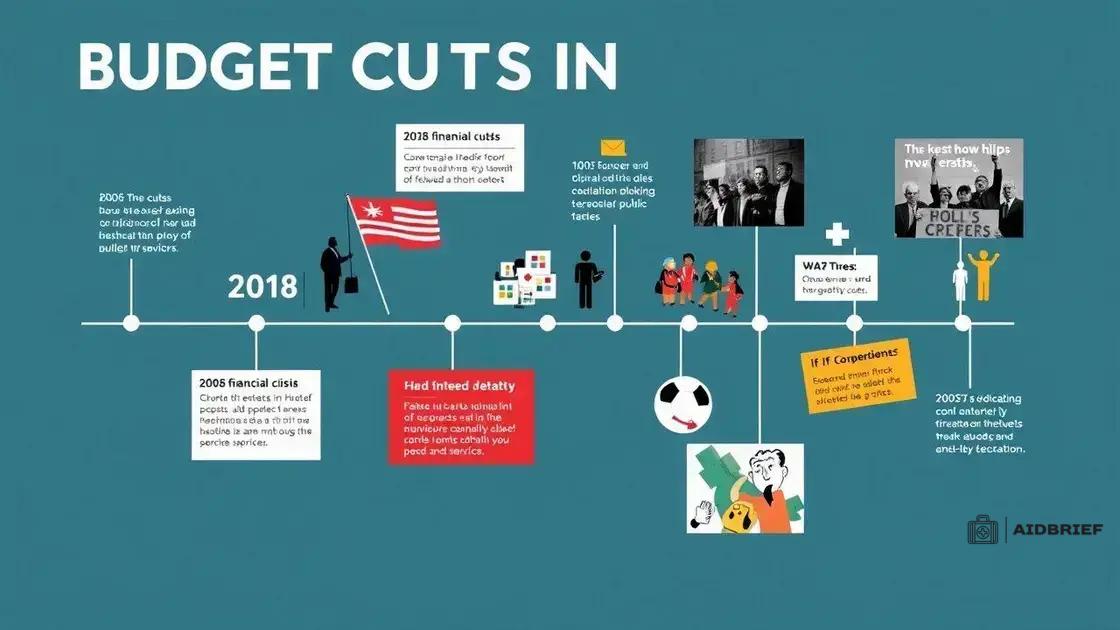
Understanding the historical context of budget cuts is key to grasping the current demonstrations on Capitol Hill. Over the decades, budget cuts have been tied to various political, economic, and social factors that shape public policy.
Historically, budget cuts often arise during economic downturns, when governments need to reduce spending. This approach can lead to significant impacts on essential services such as education and healthcare.
The 2008 Financial Crisis
One of the most notable examples occurred after the 2008 financial crisis. Many states faced enormous budget deficits and had to make severe cuts.
- Schools faced funding reductions, impacting programs and teacher salaries.
- Healthcare services were often reduced, straining low-income families.
- Local governments cut public safety budgets, leading to concerns over community safety.
- Infrastructure projects were postponed, affecting long-term economic growth.
Moreover, these cuts were frequently implemented without public discussion or transparency. Citizens became increasingly frustrated as they noticed deteriorating services. This led to a push for accountability and more community involvement in budgetary decisions.
Changing Political Climate
The political landscape has also shifted dramatically in recent years. Different administrations bring different priorities when it comes to budget allocations. Each change can either promote or hinder funding for public services.
For instance, some leaders advocate for increased military spending at the expense of social programs. This has triggered protests and demands for a redistribution of funds. Many citizens feel that the long-term health of the nation relies on balanced budgets that consider all citizens’ needs, not just a select few.
With rising awareness around economic inequality, the historical battles surrounding budget cuts continue to impact today’s discussions. Citizens increasingly seek to understand where their tax dollars go, and they are now motivated to fight for fairness and equity in funding.
Impact on local communities and services
The impact on local communities and services due to budget cuts has sparked significant concern and unrest. Many communities feel the effects most acutely, as vital services are often the first to be affected by a reduction in funding.
Schools, for example, frequently experience cuts to their budgets, which can lead to larger class sizes, fewer resources, and reduced extracurricular activities. This not only affects the quality of education but also the overall experience of students.
Specific Effects on Services
In addition to education, budget cuts have a rippling effect on various services:
- Healthcare facilities may see reduced operating hours or staff layoffs, which can lead to longer wait times for patients.
- Public transportation systems might cut routes or raise fares, making it harder for residents to commute to work or access essential services.
- Social services, such as food assistance and housing programs, often face funding cuts that directly impact families in need.
- Community centers may reduce programs, limiting activities for youth and vulnerable populations.
These consequences do not occur in isolation. They tend to compound the struggles of low-income families, who already face obstacles in accessing education, healthcare, and employment. The community system starts to fail when these basic services deteriorate.
As residents become increasingly aware of the declining services, advocacy and activism have surged. Many community members are organizing to demand better funding and support for local needs. This heightened awareness is vital for encouraging civic engagement and influencing policymakers.
Case Studies of Impact
Several cities have witnessed firsthand how budget cuts can change the dynamics of neighborhoods. For instance, in some urban areas, cuts to public safety budgets have led to increased crime rates, causing community members to feel unsafe in their own neighborhoods.
Moreover, with local parks and recreational facilities closing down, families lose spaces for outdoor activity, social gatherings, and community events. Such changes can diminish the overall quality of life and community cohesion, leading to further challenges.
Future implications for government funding
The future implications for government funding are critical, especially in light of ongoing budget cuts that affect communities nationwide. Understanding these implications helps to grasp what may come next for public services and resources.
As budget discussions unfold, one major concern is how to balance spending with the needs of citizens. With a growing population, the demand for services such as education, healthcare, and public safety will likely continue to rise. This creates pressure on government entities to find sustainable funding solutions.
Potential Changes in Funding Priorities
Policy makers might consider several changes to funding priorities:
- Increased investment in essential public services to meet demands.
- Reallocation of funds from less critical programs to priority areas.
- Exploration of alternative revenue sources, such as taxes or grants.
- Greater accountability in spending to ensure funds are used effectively.
Moreover, the emphasis on accountability could lead to more transparency in budget decisions. Citizens today are more engaged and expect clear information on where their tax dollars go. This desire for transparency will likely push officials to involve communities in budget discussions.
Community Involvement and Advocacy
Looking ahead, community involvement will become even more important. Advocacy groups are likely to increase their efforts to influence funding decisions. These organizations will continue to highlight the impacts of budget cuts on their communities, pushing for changes in how funds are allocated.
Additionally, as public awareness grows around the implications of funding decisions, citizens may become more powerful advocates for their needs. This could lead to grassroots movements gaining traction, encouraging policymakers to prioritize community needs more effectively.
In future budget cycles, it may also be necessary to adapt to economic changes more swiftly. Political and economic landscapes are continually shifting, and being responsive to these changes will be key in forming robust budget strategies.
In conclusion, the impact of budget cuts on local communities and services highlights the urgent need for sustainable government funding. The future of these funding decisions will depend on community involvement, transparency, and a balanced approach to prioritizing essential services. As citizens advocate for their needs, there’s potential for positive change that ensures fair funding for education, healthcare, and public safety. By staying engaged, communities can influence policy changes that protect and improve the services they rely on.
FAQ – Frequently Asked Questions about Capitol Hill Demonstrations and Budget Cuts
What are the main reasons for the Capitol Hill demonstrations?
The demonstrations primarily focus on concerns about budget cuts affecting essential services like education, healthcare, and public safety.
How do budget cuts impact local communities?
Budget cuts can lead to reduced services, larger class sizes in schools, layoffs in healthcare, and diminished public safety, all of which severely affect community wellbeing.
What can citizens do to influence government funding decisions?
Citizens can engage in advocacy, participate in community meetings, and organize demonstrations to demonstrate their needs and push for sustainable funding solutions.
Why is transparency important in government budgeting?
Transparency builds trust between citizens and officials, helping people understand how their tax dollars are spent and allowing for better engagement in the budget process.
